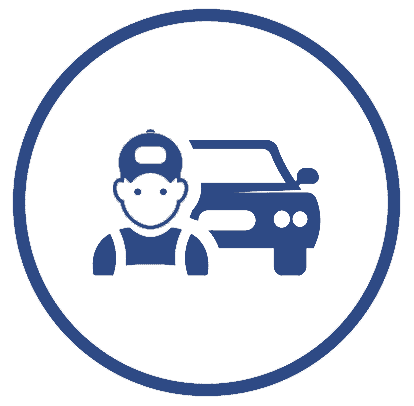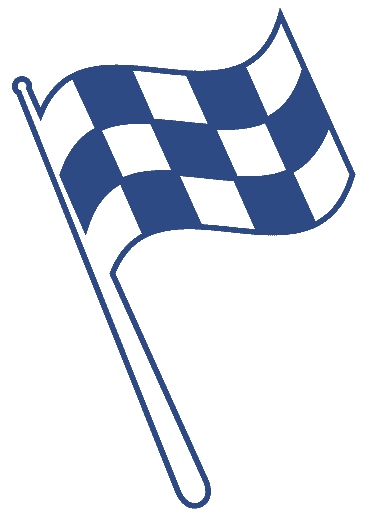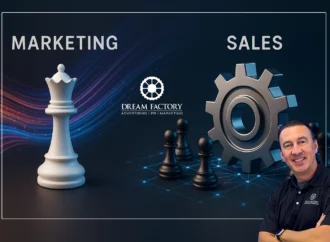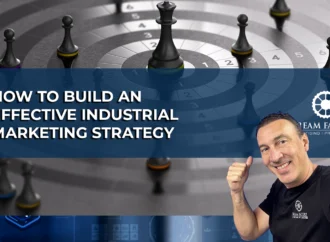5 content marketing tips to help your leads cross the finish line.
Once someone clicks into your website, it is a race to see how quickly you can convert that audience member to a sales lead. The material your audience encounters on your website is going to either encourage them to stay or make them “bounce” off your page driving in another direction. This is where content marketing becomes your best strategy. Consider your website a race track and your potential sales leads as drivers trying to reach that finish line: The Call to Action.
How can you get your audience to select that CTA and become a new sales lead?

The more information you have on your website, the more it will drive potential leads into your inbox.
Did you know:

By doing research and creating informative content on your website, you can develop b2b content that can influence your audience into becoming your next big lead.
Keep reading for five tips we have compiled to help you create a content strategy that will drive in leads.
 Checkpoint 1: Understanding your audience
Checkpoint 1: Understanding your audience
Before you can develop b2b content, you must first understand for whom you are writing. This is where your target persona or buyer persona comes into play.
A target persona is a fictional representation rooted in the behavioral data and knowledge you have gained from your clientele. It is essentially the embodiment of who you believe you are selling your service or product to-your IDEAL customer.
For example, an e-commerce site selling hair rejuvenation production should first analyze their existing clients and see what common demographic factors are present in their buyers.
Are most of the buyers a certain age or gender? Are they married with children? Are most clients purchasing from cold or warm climate areas? Are they a returning client? Which clients close at a higher ratio/value and in shorter times and which ones refer at a higher rate?
There are many factors you can consider to narrow down your target audience.
Once you have gathered enough information, you can then create a target person. It will be easier for you to envision who you are selling to and then create content that will help you funnel clients into the buyer’s journey.
Now that you have created a persona audience, ask yourself why they need to utilize your service or product to help their business. Jot those answers down as this will become part of your content creation strategy.
 Checkpoint 2: Narrow down your type of content
Checkpoint 2: Narrow down your type of content
It is important to know what type of content works best with your industry. There are all types of content you can create to get your message across to your target clientele. The common types of content created and used in b2b marketing today include:
1. Social Media posts
2. Blog posts
3. Podcasts
4. YouTube/Vimeo videos
5. Paid advertisements
For B2C [business to consumer] companies, being as social as possible would be best when spreading the word about your product. These businesses will focus on content that will generate traffic to their sites. That means having accounts on all up-to-date social media platforms, blogs, podcasts and YouTube videos among other examples.
For B2B [business to business] companies, marketing may not have to be so different from B2C. Companies that are more focused on generating leads than traffic will have to create content to inform potential clients of their products and services. Most will use blogs, informative videos, white paper reports, webinars and brochures to provide readily available and easy to digest information.
Marketing Budget
Depending on your marketing budget and the amount of time on your hands, it is important to consider how you are to distribute your b2b content, through paid or organic channels.
Organic distribution channels include search engine optimization, YouTube and social media channels, such as Facebook, Twitter and LinkedIn. While posting to these channels does not require any paid advertising, it will need more time devoted to it to produce the results you want.
**This is perfect for companies that have a lower marketing budget.**
Paid distribution channels include social media advertisements, native advertisements, content discovery networks and Google Adwords. This does require companies to spend some money, but the results will generate a lot quicker than organic distribution.
Did you know:

 Pit stop: Brainstorm with your team
Pit stop: Brainstorm with your team
Now that you understand who you are writing for, the types of content you can utilize and where you want to publish your work, it is time to contemplate what to write about. Developing b2b content ideas can be somewhat difficult if you are doing it all on your own; getting together with your team can help you get the “creative juices flowing”.
Your company and team should be aligned in such a manner that everyone understands your company’s end goal and overall mission. When it comes to projects to enhance leads and generate content, an aligned team should have no problem coming together to discuss creative and innovative content for your company.
Not only will content marketing meetings help with the creative writing process, but it can be a great team building exercise for members of your company as well.
Check out our blog on the importance of aligning your departments within your company.
 Checkpoint 3: Create Content
Checkpoint 3: Create Content
Now comes the important part, creating the content that will capture the attention of your audience.
You know…
1. Who your audience is
2. The type of content you need to utilize
3. Where to publish content
4. The ideas you have received from your team.
It is time to create content!
Here are some important aspects of content creating to remember when you are sitting at the computer:
Have an enticing headline
According to Copyblogger, on average 8 out 10 people will read a headline of a copy but only 2 will read the rest.
Imagine your headlines as the hook to your content. You know what your audience wants to know; give them a title that ensures they will find the solution they need in your content.

Educational but easy to understand
The last thing your content needs to be is boring. Ensure when creating content, you are communicating in a conversational tone. If your product or service is complicated but you know the functionality of it like the back of your hand, then write it in a way that will be easy to digest for your readers.
If creating a blog, do not overload your post with extra-long paragraphs filled with information. Break it up into small paragraphs consisting of two to three sentences. If possible, create bulleted lists and break up headers with sub-headers.
Also, remember just to tell your story. Check out our blog on how storytelling can help with your content.
Visuals
Everything is more fun with pictures. If you are writing a blog, include high quality images of your products or graphics to break up your sections and keep your reader’s attention.
If you are creating a video, be sure to use high quality video and audio, try to make it look as professional as possible. Don’t be afraid of taking more than one take.

Keyword Utilization
Remember if you are utilizing organic distribution channels, it is important to use certain keywords in your text and headline. In doing so, search engines like Google can pull your content because you have relevant information in what the client may be searching for.
Links, links, links
Did you know:

Keep the chain going in your content to previous published works. By linking back and referencing previously published content, you are allowing your audience to gain a better understanding of what your company can do for them.
This is driving traffic to other pages within your site and allows for the audience to become more interested in your company, thus edging them forward to being a potential client.

 Finish Line: Call To Action
Finish Line: Call To Action
Now, the important part. Have your potential audience cross the finish line in your call to action (CTA) at the end of your content. Use this opportunity to create a catchy one to two sentences that will entice your interested audience to click your link to either contact you or be given the opportunity to access gated content.
The easiest call to action would just simply say, “Click here for…” or “Call Now”. This is boring and best practices recommend being more specific with your CTA. Don’t be afraid to get a little creative with your call to action. Get your graphic designer involved to make a nice graphic link or research fun and innovative ways to hook in a client through a call to action.
It is also important to create a clear conversion path within your call to act. Setting a clear expectation is key to converting your audience to a client. For example, if you are offering gated content such as an eBook in your call to action, be sure to utilize the same image in the call-to-action link as well as the landing page it will take your potential client to.
Consistency and creativity with your call to action is important when generating leads.
Did you know:

If you get stuck trying to develop a catchy call to action, simply remember these three tips to create a CTA that will help you land those leads:
1. Give your audience a reason they would want to click in to your call to action.
“Call today for a free consultation!”
2. Use words that will invoke enthusiasm or emotion with your audience.
“Plan your dream getaway now!”
3. Use a strong verb in the beginning of your CTA
“Fill out a form for…” “Call today…”
By utilizing these tips and a little creativity, you can write a CTA that will help drive those leads over your finish lines and into your sales books.
Developing Content that Works for You
At Dream Factory, we understand the importance of developing b2b content within an overall content marketing strategy that works. With over 20 years of experience in the B2B marketing space, let us help you to create valuable, ROI – focused content that will engage the leads you need to succeed.
Speak with one of our marketing professionals today to analyze and create a content strategy that will benefit your company.
Your bottom line is as important to us as it is to you.
Find out how we can help you drive more leads.





![How to Build a B2B Content Marketing Strategy That Actually Drives Sales [2025 Guide]](https://www.dreamfactoryagency.com/wp-content/uploads/2025/04/b2b-content-marketing-strategy-330x242.jpg)

